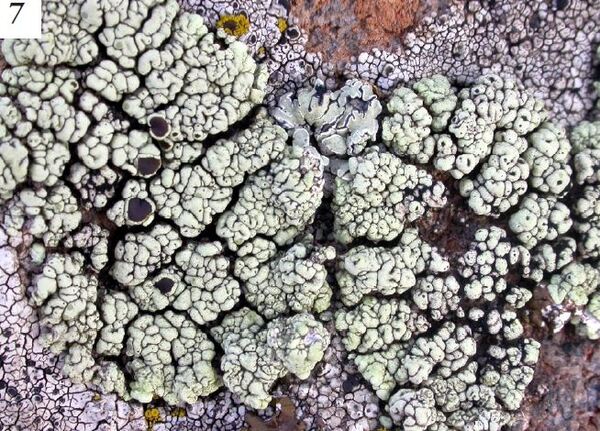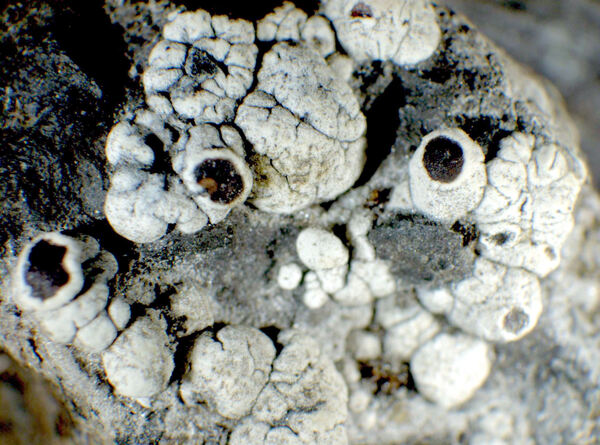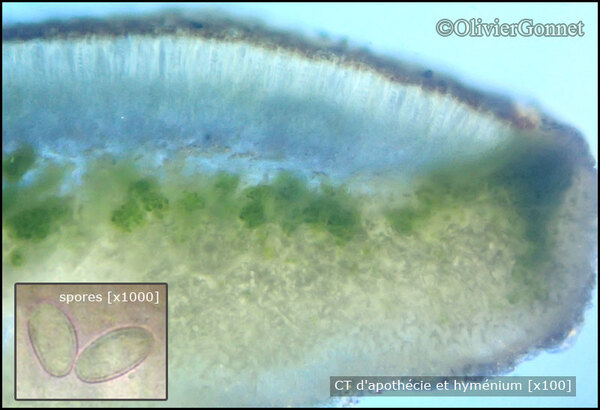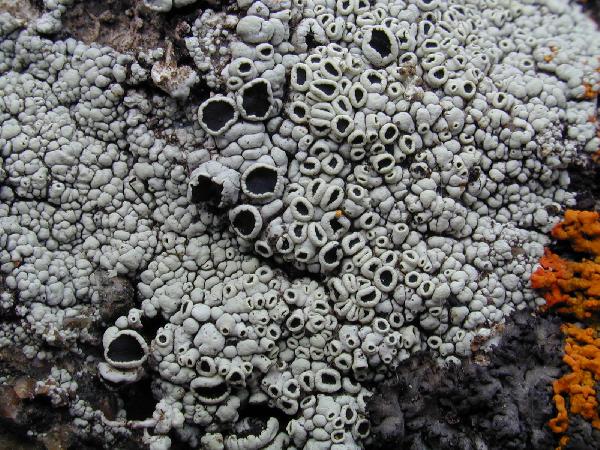Lecanora frustulosa (Dicks.) Ach.
Lichenogr. Univ.: 405, 1810. Basionym: Lichen frustulosus Dicks. - Fasc. Pl. Crypt. Brit., 3: 13, 1793.
Synonyms: Lecanora frustulosa var. ludwigii (Spreng.) Th. Fr.; Lecanora hydrophila Sommerf.; Lecanora insulata (Ramond) Steud.; Lecanora ludwigii (Spreng.) Ach.; Lecidea bossoniana Croz.; Patellaria frustulosa (Dicks.) Trevis.; Toninia bossoniana (Croz.) Zahlbr.
Description: Thallus crustose, episubstratic, areolate to almost subsquamulose, pale cream-yellow to yellowish white, with a usually well-developed, black prothallus, the areoles contiguous to usually dispersed, 1-1.5 mm wide, convex, sometimes almost globular, attached by an umbilicus-like bundle of hyphae, the peripheral ones often elongate and somewhat radiating. Cortex (25-)40-50 µm thick, of more or less anticlinally arranged hyphae, filled with coarse, 3.5-7 µm wide, colourless crystals not dissolving in K and in N; medulla white in upper part, often brown in lower part, filled with crystals. Apothecia frequent, lecanorine, (0.6-)1-2(-3) mm across, at first adnate, then broadly sessile, with a brown to brown-black, epruinose, slightly concave to convex disc and a thin, subcrenulate, hardly prominent, finally often excluded thalline margin. Thalline exciple corticate, the cortex 25-50 µm thick, filled with crystals; proper exciple 20-40 µm wide; epithecium brown, N-, overlain by a 3-5 µm thick colourless layer; hymenium colourless, 50-90 µm high, I+ blue; paraphyses simple or sparingly branched in upper part, 1.5-2.5 µm thick at mid-level, the apical cells to 4.5 µm wide; hypothecium colourless. Asci 8-spored, clavate, very thin-walled, with a K/I+ blue, tall tholus penetrated by a faintly amyloid apical cushion, the wall K/I-, surrounded by a blue outer layer, Lecanora-type. Ascospores 1-celled, hyaline, narrowly ellipsoid to ellipsoid, 9-16(-18) x 4-7(-9) µm. Pycnidia immersed, ovoid to subglobose, the wall colourless except near the dark ostiole. Conidia thread-like, straight or curved, 21-39 x c. 0.5 µm. Photobiont chlorococcoid. Spot tests: cortex K+ yellow to pale yellow, sometimes K-, C-, KC+ yellow, P+ yellow to orange-yellow, UV+ dull orange; medulla always K-, P- or P+ pale orange yellow. Chemistry: usnic acid (major, in cortex only), sometimes with different combinations of stictic, norstictic, and cryptostictic acids, epanorin, zeorin, fatty acids (minor or absent).
Growth form: Crustose
Substrata: rocks
Photobiont: green algae other than Trentepohlia
Reproductive strategy: mainly sexual
Subcontinental: restricted to areas with a dry-subcontinental climate (e.g. dry Alpine valleys, parts of Mediterranean Italy)
Commonnes-rarity: (info)
Alpine belt: very rare
Subalpine belt: rare
Montane belt: very rare
Dry submediterranean belt: absent
Humid submediterranean belt: absent
Padanian area: absent
pH of the substrata:
1 2 3 4 5
Solar irradiation:
1 2 3 4 5
Aridity:
1 2 3 4 5
Eutrophication:
1 2 3 4 5
Poleotolerance:
0 1 2 3
Altitudinal distribution:
1 2 3 4 5 6
Rarity
absent
extremely rare
very rare
rare
rather rare
rather common
common
very common
extremely common
Loading data...
Occurrence data
Predictive map

Source: Roux C., Bertrand M., Poumarat S., Uriac P. 2022. Quelques espèces nouvelles saxicoles – calcifuges de Lecanora du groupe polytropa (Ascomycota, Lecanoraceae) découvertes en France. Bull. Soc. linn. Provence, 73: 79-120.
Growth form: Crustose
Substrata: rocks
Photobiont: green algae other than Trentepohlia
Reproductive strategy: mainly sexual
Subcontinental: restricted to areas with a dry-subcontinental climate (e.g. dry Alpine valleys, parts of Mediterranean Italy)
Commonnes-rarity: (info)
Alpine belt: very rare
Subalpine belt: rare
Montane belt: very rare
Dry submediterranean belt: absent
Humid submediterranean belt: absent
Padanian area: absent
pH of the substrata:
| 1 | 2 | 3 | 4 | 5 |
Solar irradiation:
| 1 | 2 | 3 | 4 | 5 |
Aridity:
| 1 | 2 | 3 | 4 | 5 |
Eutrophication:
| 1 | 2 | 3 | 4 | 5 |
Poleotolerance:
| 0 | 1 | 2 | 3 |
Altitudinal distribution:
| 1 | 2 | 3 | 4 | 5 | 6 |
Rarity
absent
extremely rare
very rare
rare
rather rare
rather common
common
very common
extremely common
Loading data...
Occurrence data
Predictive map












